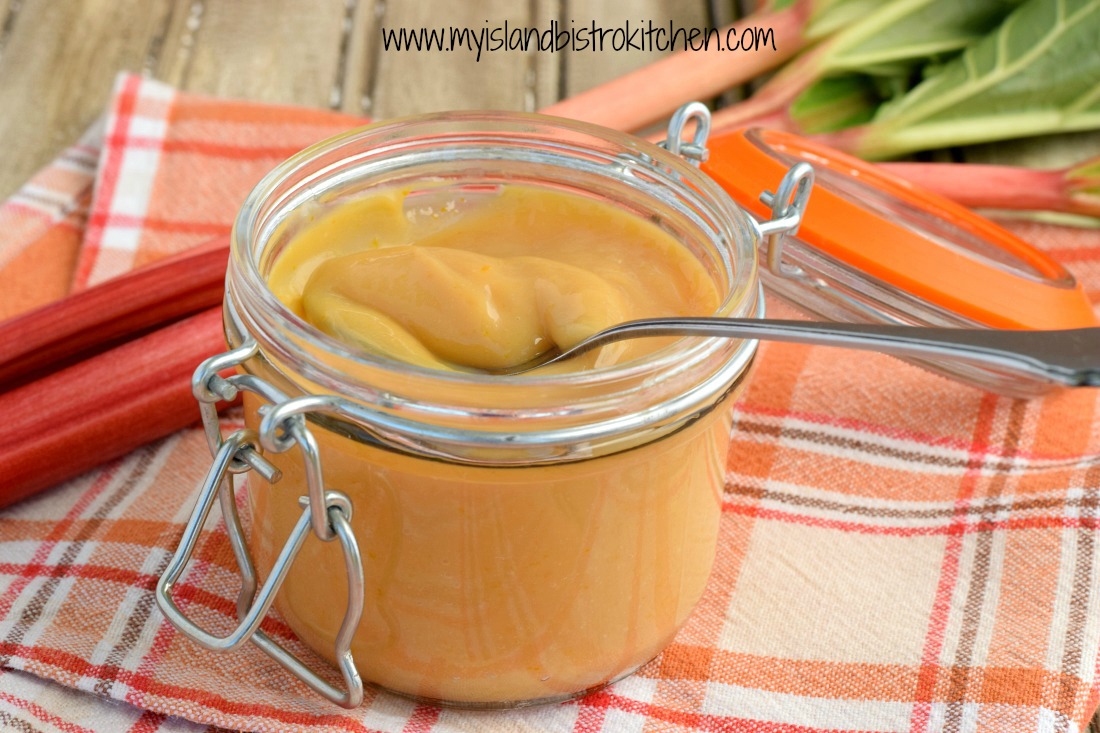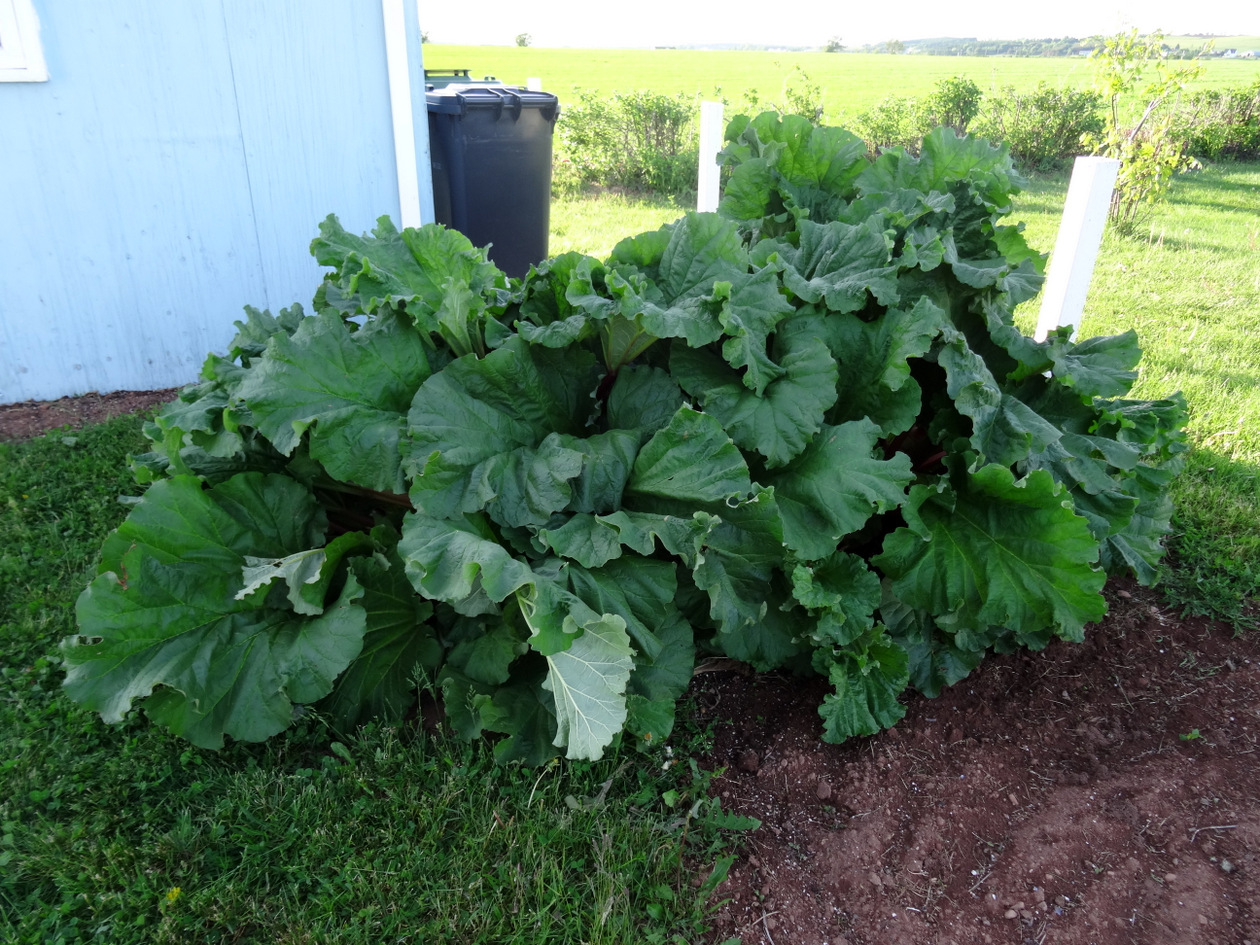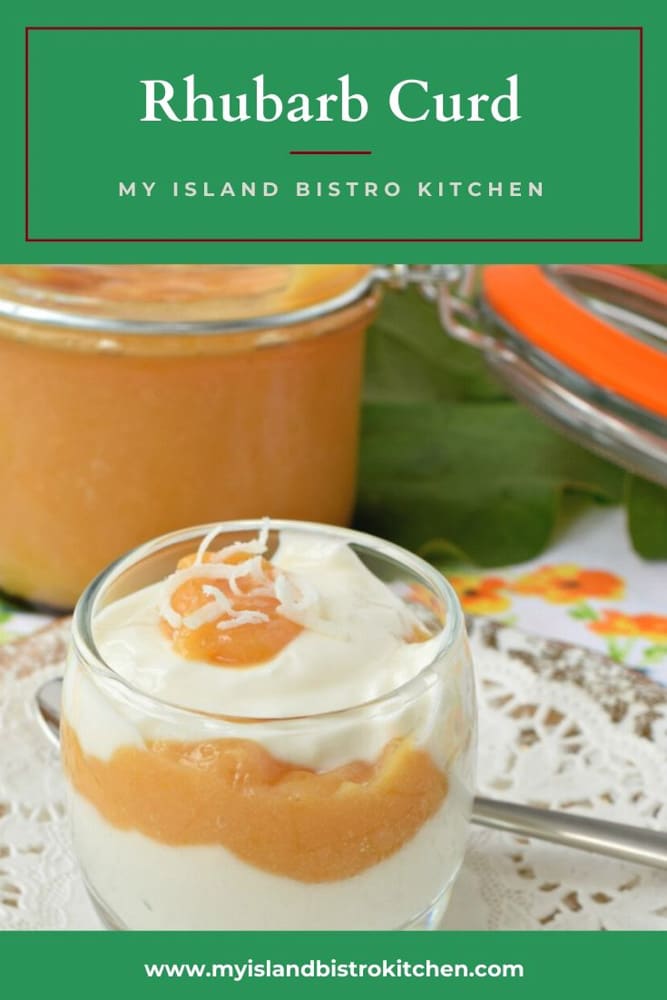
I love rhubarb and use it in a multitude of ways. Being a lover of lemon curd, I figured I would also like rhubarb curd so I set about developing and testing a recipe for it. This delightful creamy curd can be used in the same ways as lemon curd – sandwiching cakes together, spreading on scones, filling cookies, eclairs, macarons, and tarts, stirring into (or topping on) Greek yogurt for quick parfaits, and, well, its uses are only limited by your imagination!

Rhubarb curd is made with only five (5) ingredients – rhubarb, orange (juice and zest), sugar, eggs, and butter. The recipe I am including with this posting is the result of several testings. Here are my tips for successfully making rhubarb curd.
Rhubarb

Either fresh or frozen rhubarb can be used for this recipe; however, I always advocate for fresh. Try to select the reddest stalks you can find and ones that are blemish free.

Orange Juice and Zest
Wash the orange really well in hot, soapy water and scrub it with a vegetable brush. Rinse the orange well and dry it before zesting.
Use a citrus fruit zester to zest the orange. This should yield about 2 teaspoons of zest. This zesting process will release the aromatic oils from the orange that will enhance the flavor of the curd. When zesting the orange, take care only to remove the thin outside orange skin of the fruit and not the underlying white pith which is bitter.
Cut the orange in half and squeeze it to extract the juice. Alternatively, bottled orange juice may also be used.
Eggs
I have tested this curd using various amounts and combinations of eggs -i.e., different sized eggs, egg yolks only, and combining egg yolks with some egg white.

While all combinations I tried were acceptable, I found that my preference is to use 3 extra-large egg yolks combined with one medium-sized whole egg. I always keep three sizes of eggs in my refrigerator – extra-large, large, and medium – because I use different sizes in different recipes and various combinations of egg sizes in recipes. I find adding a bit of egg white to the curd gives a bit more fluidity and makes it more silky smooth. Making the curd with only egg yolks tends to result in slightly thicker textured curd that has a more gelatin-like consistency which is not quite as satiny smooth as can be achieved by adding a bit of egg white. It’s still tasty but just not as creamy. The photo below is of a curd made with egg yolks only.

Adding a whole extra-large egg adds too much liquid to the curd but I found that the addition of a medium-sized egg is perfect as there is just enough white in the medium egg to give the curd that little bit of fluidity without making it overly runny. The photo below is of a curd made with 3 extra-large egg yolks and 1 whole medium-sized egg.

I like the rhubarb curd to be soft but not overly runny or too thick – it should more or less stay in place when a dollop of it is added to the top of yogurt or dropped on to a scone or biscuit, for example.

The problem that often occurs with adding an egg white to a curd is that the white, or parts of it, can coagulate before being fully incorporated into the curd meaning the white goes from liquid form to a solid. Egg whites cook faster than the yolks so, no matter how much stirring, there can still be little bits of the coagulated egg white in the curd because, once the white has turned into solid mass, it can’t be liquified again. This is easily remedied, however, by straining the cooked curd through a fine wire mesh sieve to remove any little bits of egg white remaining. You would think the thickened curd would not drip through the sieve but, amazingly, it does! Don’t skip this step.
Sugar
This curd is best made with caster sugar which you may know by any of the following names: Fruit sugar, instant dissolving sugar, berry sugar, or super fine sugar. This sugar is extra fine. It dissolves much faster than granulated sugar and is commonly used in making simple syrups used in cocktails because it leaves no “gritty” texture. Regular granulated sugar may be used but, if a pure silky smooth curd is the goal, I recommend using the caster sugar.
Method
Making rhubarb curd takes time. I do not recommend making the rhubarb curd in a pot directly over the heat source because it is very easy to scorch the curd with the amount of sugar in it. My preference is to use a double boiler. If you don’t have one of these sets of pots, simply set a heatproof bowl over a pot of simmering water.
It’s very important that the top pot/bowl in the double boiler not touch the water in the bottom pot. The curd cooks from the steam heating the top saucepan of the boiler, not by contact with water. About 2” of water in the bottom of the pot is all that is required. Heat this water to the simmering point (around 200°F) and do not let it boil as this will cook the eggs in the curd too fast. This is when curdling can occur and the mixture will become lumpy and lose its smooth texture. The water should be kept at this 200°F temperature throughout the cooking process. (Note that temperatures for the simmering water may need to be adjusted according to altitude. The important thing is that the water not boil.)
I add the orange zest at the beginning of the cooking process because that’s when I think the zest can do the most to enhance the flavor of the curd. Simply stir the orange zest into the sugar in the top of the double boiler then whisk in the rhubarb juice. Mix the egg yolks and the whole egg together in a small bowl, using a fork to lightly break them up. Whisk the eggs and softened butter into the sugar-juice mixture. Place this pot/heatproof bowl on top of the pot of simmering water.
The mixture needs to be stirred regularly as it cooks. A whisk or a wooden spoon can be used to stir the curd. Be patient. This cooking process can easily take 20-25 minutes for the curd to thicken. Resist the urge to increase the heat to hurry the cooking process along. The curd, when cooked, will coat the back of a wooden spoon. However, the most accurate test is to use a candy thermometer – the curd is cooked when the temperature reaches 170°F.
The curd needs to be strained through a very fine wire mesh sieve to remove any bits of the coagulated egg white along with the orange zest. The zest has done its duty by releasing flavor into the curd. There is no harm in leaving the zest in the curd; however, if the goal is to have a perfect silky finish to the curd, strain out the zest.
Color and Texture
The color of the cooked curd will not be a vibrant red as was the rhubarb juice to start. The color becomes a paler salmon pink/soft orange color because of the addition of the eggs which dilutes the ruby red color of the rhubarb juice. The texture of the perfectly cooked curd should be silky smooth and very creamy, and the curd should bear a slightly glossy sheen. The rhubarb curd will thicken slightly more as it cools. A true curd does not have any thickening agent (e.g., flour or cornstarch) added to it. The egg yolks are what naturally thickens the curd.

Storage
Transfer the strained curd to a hot sterilized jar. Immediately place a piece of plastic wrap on the exposed surface of the curd in the jar, pressing it gently to ensure it is in direct contact with the entire surface of the curd. This will prevent a skin from forming on the curd as it cools. Let the curd cool to room temperature then remove the plastic wrap, cover tightly with jar lid, and store in the refrigerate for up to a week.

[Printable recipe follows at end of posting]
Rhubarb Curd
Ingredients:
10 oz rhubarb, chopped into ½” chunks
2 tbsp orange juice
2/3 cup caster sugar
2 tsp orange zest
3 extra-large egg yolks, room temperature
1 whole medium egg, room temperature
3 tbsp unsalted butter, softened
Method:
Place chopped rhubarb and orange juice in medium-sized saucepan. Cover. Bring to a boil over medium-high heat. Immediately reduce heat to medium-low and cook, stirring occasionally, until rhubarb is soft and mushy (about 5-8 minutes). Remove from heat and strain through fine wire mesh sieve to extract the rhubarb juice, squeezing as much juice as possible out of the rhubarb by gently pressing it down with the back of a spoon. This should yield approximately ½ cup rhubarb juice. Cool. Discard the strained pulp.
In bottom of double boiler, bring about 2” of water to the simmer point (around 200°F). Maintain the water at this simmer point over medium-low heat. Place sugar in top of double boiler or heat-proof bowl. Mix in the orange zest. Whisk the ½ cup rhubarb juice into sugar.
In small bowl, lightly beat the 3 egg yolks and the whole egg together with a fork, just enough to break up the yolks and blend with the whole egg. Whisk the eggs into the sugar and rhubarb juice mixture. Add the soft butter. Place this pot or bowl over the simmering water. Stir the mixture continuously as it cooks until it is thickened and the temperature of the mixture registers 170°F on a candy thermometer. Be patient as this may take 20-25 minutes. Make sure the water in the bottom of the boiler does not boil and stays only at the simmer point.
Remove curd from heat and strain through a mesh strainer to remove any of the egg white that may have coagulated as well as the orange zest. Pour strained curd into a sterilized jar. Place a piece of plastic wrap directly on the surface of the curd to prevent it from forming a skin on top. Cool at room temperature. Remove plastic wrap. Cover jar tightly and refrigerate for up to 1 week.
Yield: Apx. 1 cup
*caster sugar may also be known as fruit sugar, berry sugar, super fine sugar, or instant dissolving sugar.
Note: Altitude may affect the temperature at which the water reaches the simmering point. The important thing is that the water in the bottom of the double boiler does not boil or touch the top of the double boiler/heatproof bowl during the cooking of the curd.
You may also enjoy these other delicious curd recipes from My Island Bistro Kitchen:
Lemon Curd
Cranberry Curd
Lime Curd
Clementine Curd
Rhubarb Curd Recipe
A delightful creamy smooth rhubarb curd that is perfect for spreading on muffins, scones, or biscuit or adding to yogurt parfaits
Ingredients
- 10 oz rhubarb, chopped into ½” chunks
- 2 tbsp orange juice
-
- 2/3 cup caster sugar*
- 2 tsp orange zest
- 3 extra-large egg yolks, room temperature
- 1 whole medium egg, room temperature
- 3 tbsp unsalted butter, softened
-
- *caster sugar may also be known as fruit sugar, berry sugar, super fine sugar, or instant dissolving sugar
Instructions
- Place chopped rhubarb and orange juice in medium-sized saucepan. Cover. Bring to a boil over medium-high heat. Immediately reduce heat to medium-low and cook, stirring occasionally, until rhubarb is soft and mushy (about 5-8 minutes). Remove from heat and strain through fine wire mesh sieve to extract the rhubarb juice, squeezing as much juice as possible out of the rhubarb by gently pressing it down with the back of a spoon. This should yield approximately ½ cup rhubarb juice. Cool. Discard the strained pulp.
- In bottom of double boiler, bring about 2” of water to the simmer point (around 200°F). Maintain the water at this simmer point over medium-low heat. Place sugar in top of double boiler or heat-proof bowl. Mix in the orange zest. Whisk the ½ cup rhubarb juice into sugar.
- In small bowl, lightly beat the 3 egg yolks and the whole egg together with a fork, just enough to break up the yolks and blend with the whole egg. Whisk the eggs into the sugar and rhubarb juice mixture. Add the soft butter. Place this pot or bowl over the simmering water. Stir the mixture continuously as it cooks until it is thickened and the temperature of the mixture registers 170°F on a candy thermometer. Be patient as this may take 20-25 minutes. Make sure the water in the bottom of the boiler does not boil and stays only at the simmer point.
- Remove curd from heat and strain through a mesh strainer to remove any of the egg white that may have coagulated as well as the orange zest. Pour strained curd into a sterilized jar. Place a piece of plastic wrap directly on the surface of the curd to prevent it from forming a skin on top. Cool at room temperature. Remove plastic wrap. Cover jar tightly and refrigerate for up to 1 week.
- [Copyright My Island Bistro Kitchen]
Notes
Note: Altitude may affect the temperature at which the water reaches the simmering point. The important thing is that the water in the bottom of the double boiler does not boil or touch the top of the double boiler/heatproof bowl during the cooking of the curd.
Schema/Recipe SEO Data Markup by Yummly Rich Recipeshttps://myislandbistrokitchen.com/2017/07/12/rhubarb-curd-recipe/
A delightful creamy smooth rhubarb curd that is perfect for spreading on muffins, scones, or biscuit or adding to yogurt parfaits
Ingredients
- 10 oz rhubarb, chopped into ½” chunks
- 2 tbsp orange juice
- 2/3 cup caster sugar*
- 2 tsp orange zest
- 3 extra-large egg yolks, room temperature
- 1 whole medium egg, room temperature
- 3 tbsp unsalted butter, softened
- *caster sugar may also be known as fruit sugar, berry sugar, super fine sugar, or instant dissolving sugar
Instructions
- Place chopped rhubarb and orange juice in medium-sized saucepan. Cover. Bring to a boil over medium-high heat. Immediately reduce heat to medium-low and cook, stirring occasionally, until rhubarb is soft and mushy (about 5-8 minutes). Remove from heat and strain through fine wire mesh sieve to extract the rhubarb juice, squeezing as much juice as possible out of the rhubarb by gently pressing it down with the back of a spoon. This should yield approximately ½ cup rhubarb juice. Cool. Discard the strained pulp.
- In bottom of double boiler, bring about 2” of water to the simmer point (around 200°F). Maintain the water at this simmer point over medium-low heat. Place sugar in top of double boiler or heat-proof bowl. Mix in the orange zest. Whisk the ½ cup rhubarb juice into sugar.
- In small bowl, lightly beat the 3 egg yolks and the whole egg together with a fork, just enough to break up the yolks and blend with the whole egg. Whisk the eggs into the sugar and rhubarb juice mixture. Add the soft butter. Place this pot or bowl over the simmering water. Stir the mixture continuously as it cooks until it is thickened and the temperature of the mixture registers 170°F on a candy thermometer. Be patient as this may take 20-25 minutes. Make sure the water in the bottom of the boiler does not boil and stays only at the simmer point.
- Remove curd from heat and strain through a mesh strainer to remove any of the egg white that may have coagulated as well as the orange zest. Pour strained curd into a sterilized jar. Place a piece of plastic wrap directly on the surface of the curd to prevent it from forming a skin on top. Cool at room temperature. Remove plastic wrap. Cover jar tightly and refrigerate for up to 1 week.
- [Copyright My Island Bistro Kitchen]
Notes
Note: Altitude may affect the temperature at which the water reaches the simmering point. The important thing is that the water in the bottom of the double boiler does not boil or touch the top of the double boiler/heatproof bowl during the cooking of the curd.
If you have made this recipe and enjoyed it and/or wish to share it with your friends and family, please do so on social media but be sure to share the direct link to this posting from my website.
Connect with My Island Bistro Kitchen on Social Media
Join the Facebook page for My Island Bistro Kitchen: https://www.facebook.com/MyIslandBistroKitchen/
Follow “the Bistro” on “X” (formerly Twitter): https://twitter.com/PEIBistro/
See the drool-worthy gallery of mouth-watering food photos from My Island Bistro Kitchen on Instagram: https://www.instagram.com/peibistro/
Follow “the Bistro” on Pinterest at https://www.pinterest.ca/peibistro/ and pin the Pinterest-ready photo found at the end of this post to your favorite Pinterest boards.
PIN ME TO PINTEREST!


